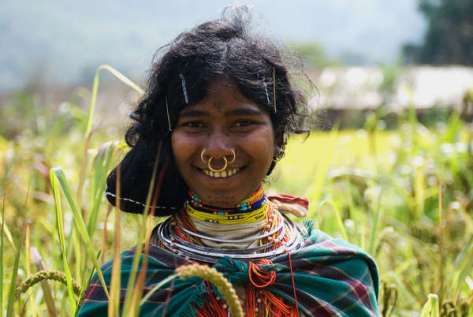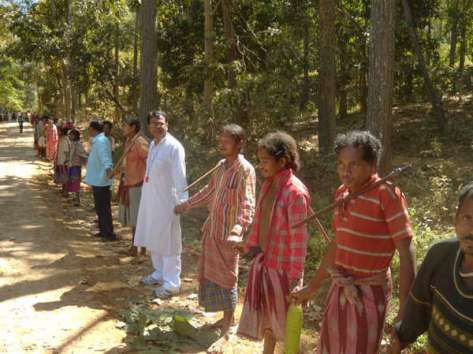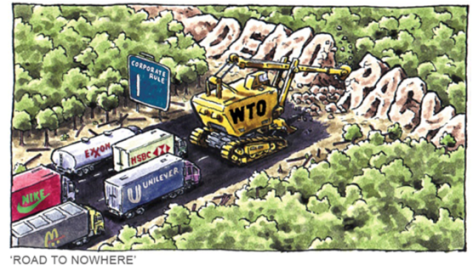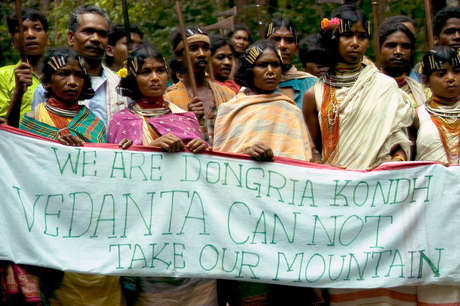
Niyamgiri hill otherwise known as Niyam Dongar, is located in the southwestern part of Odisha, between the districts of Kalahandi, Koraput and Rayagada. The hill range is home to an indigenous tribal community called the Dongaria Kondhs. The word Dongar means agricultural land on the hill slopes. The Dongarias generally live in the hill slopes and are known for their expertise in agriculture. According to the Dongaria mythology, the Dongarias have descended from Niyam Raja Penu who lives at the top of Niyamgiri hill. Thus they believe that being the descendants of Niyam Raja makes them the rightful owner of the land. Also according to the Dongarias, the land can’t be used for anything but agriculture because the ancestral spirit of Niyam Raja haunts the Dongar lands. It is the spirit of Niyam Raja that apparently is the reason for the good crop yield. The social and cultural practices of the Dongarias protect and nurture the life in the forest. Thus creating a sustainable relationship of mutual dependence between the environment and the tribe. This important since Niyamgiri is an ecologically sensitive zone. In fact, owing to its rich biodiversity, in 1998 Orissa Wildlife Division had proposed to create a wildlife sanctuary in Kalahandi which incorporated the Niyamgiri hills i. Niyamgiri is also has a rich reserve of bauxite, iron ore, chromite, nickel, coal, diamond and various other minerals.

Vedanta Aluminium Limited is a subsidiary of Sterlite Industries India Limited which is further owned by UK-based company Vedanta Resources. Vedanta Resources is an LSE (London Stock Exchange) listed company and is constituent of the FTSE (Financial Times Stock Exchange) 250 index. The company is primarily interested in mining aluminium, copper, zinc, lead, silver, iron ore, oil and gas. It has several projects spread over eight countries through dozens of operations, mainly in India and Africa ii.
On 7th June 2003, Vedanta Aluminium Ltd. (VAL) signed a Memorandum of Understanding (MoU) with the Odisha Mining Corporation Ltd. (OMCL) for the construction of an Aluminium refinery in Lanjigarh, Kalahandi district. It is a 1 MTPA (one million ton per annum) Alumina Refinery with a 3×30 MW coal-fired cogeneration power plant iii. The plan was to mine bauxite from the Niyamgiri hills (Lanjigarh is at the foothills of Niyamgiri), to produce Aluminium in the Lanjigarh plant. They had built this plant without legal permission for mining bauxite from Niyamgiri. In fact, the document submitted by VAL to Ministry of Environment and Forests (MoEF) on June 3, 2003, claimed that there were no reserve forests within a 10 km radius of the project site, which is in contradiction to the facts. According to MoEF guidelines, the company is supposed to get an environmental clearance before starting construction. And MoEF pointed this out to VAL on March 24, 2004. But six months later the ministry changed its stand and gave an environmental clearance to Vedanta for construction of the refinery iv.
On September 21, 2005, Central Empowered Committee (CEC) after looking into the matter, submitted a report to the Supreme Court. The report questioned the methods used by Vedanta and the involvement of the local authorities in the matter along with the environmental impact assessment, of the project and its violation of tribal rights. It appealed to revoke Vedanta’s Environmental clearance and to stop the project in Niyamgiri. But this was rejected by the Supreme Court on August 8, 2008. This is when the main popular phase of the struggle began and the story of the Dongaria Kondhs came to the attention of the mainstream media and international human rights groups.

The next two years saw a series of protests and demonstrations by the Dongaria Kondhs in Niyamgiri and various human rights groups showing their solidarity through protests in London in front of the Vedanta office. In 2010 the government of India sent a fact-finding team to assess the effect of mining in Niyamgiri. The team reported that the indeed Vedanta mining in Niyamgiri would have damaging consequences both for the environment and the Kondhs living there. In July 2011, the environmental minister Jairam Ramesh revoked the environmental clearance following which in 2012 Vedanta closed its Lanjigarh factory due to the insufficient supply of Bauxite. Meanwhile, the Odisha government petitioned to reverse the mining ban, to this Supreme court passed the judgement to give the Dongaria Kondhs decisive power on the mining ban. The decision was taken by 12 gram sabha all of which voted against the mining.
The struggle between the Dongaria Kondhs and Vedanta began all the way back in around 2004 but the struggle didn’t receive much attention till around 2010 when Supreme Court of India rejected the appeal to revoke the environmental clearance. Most of the local newspapers that report the incident, draw a ‘primitive’ image of Niyamgiri. And the usage of primitive here carries a negative connotation to it, the tribe is described as living in poor conditions and need to be integrated into the modern mainstream society. This kind of narrative influences the perception of the mainstream society, since it is reducing or belittling the religious traditions, practices of the Kondhs and therefore disregarding the importance of the struggle. Also the development narrative is very popular in the Oriya media, which claims that the tribe is tired of the NGOs hindering the chances of development in Niyamgiri. These kind of stories are mainly from the newspapers which support the ruling party. Similarly, the national newspapers like Times of India report Rahul Gandhi as the saviour of Niyamgiri and credit his efforts to be the cause of Supreme Court’s verdict.
Political Lobbying:-
In 2010 when N.C. Saxena Committee submitted its report on the Environmental and social impact assessment of the Vedanta mining project, the MoEF announced the revocation of Vedanta’s Environmental clearance. The real reason behind MoEF’s decision is believed to be corporate lobbying, Vedanta’s apparently used the Niyamgiri issue to hinder Vedanta’s aggressive success in mining. At the same time, Rahul Gandhi had started allying with the tribals in their struggle. Rahul Gandhi criticised Naveen Patnaik’s blatant disregard for the right of the indigenous and his misuse of power to help the multinational companies instead. Obviously, Gandhi’s involvement meant there had to be a political agenda behind it.
BJD has been in power for more than two decades in Odisha and Congress has little power in the state. For the Congress, this was a perfect time to gain popular support and vote banks. Political parties often use unrest among the people to gain political support, as we see in the case of Singur-Nandigram in West Bengal.
Conclusion
The Niyamgiri-Vedanta conflict is what many would refer to as the classic case of a local indigenous community being exploited by the powerful multinational company whose only aim is to make profit, whatever may the consequences be.
The Vedanta-Niyamgiri struggle is a highly complex issue and includes more than just q binary struggle behind Dongaria Kondhs and Vedanta. There are many other factors that played in such as the state vs centre, use of the Maoists labelling to control the struggle, the local goons and international protests. All of these factors clubbed together along with a decade-long history.
But one the few things that we can conclude from this is the to understand the difference between the definition of development. “Economic growth” today is mainly focused on the extraction of mineral, water and forest resources to meet the demands of industrial and economic growth for the ‘civilized’ population of the world. It is not that culture of “Civilized” or city-centric dominant communities is worth more than the traditions, economy, the culture of the tribal groups. They are not the only inhabitants of this planet and have no more rights to the world’s mineral, water and forest resources than the original/ indigenous inhabitants of the forests.
For more information :
https://www.survivalinternational.org/tribes/dongria
https://www.survivalinternational.org/about/niyamgiri
http://www.caravanmagazine.in/vantage/odisha-bauxite-mining-fake-surrender-niyamgiri


